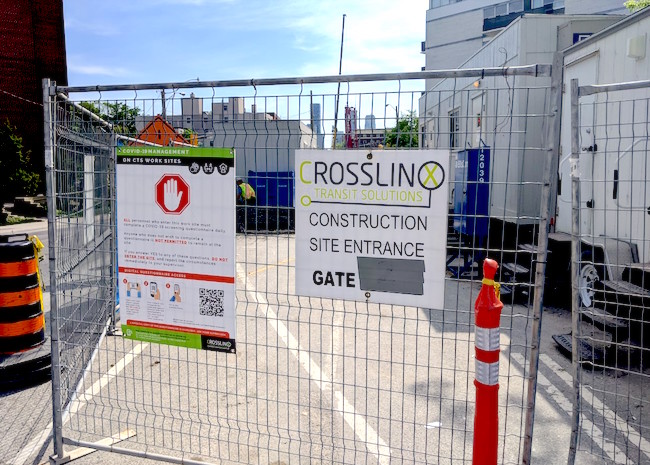
Contractors should take steps to maximize surety credit as COVID-19 threatens to toughen market
By David Kennedy
Construction Financing Infrastructure Risk Management
A COVID-19 warning sign outside an Eglinton Crosstown job site in Toronto. An influx of large government projects like the LRT could squeeze the amount of bonding capital available
COVID-19 has disrupted work on job sites coast to coast, and the pandemic is expected to limit productivity on the ground for at least several more months.
But the virus’s impact on the industry is not limited to construction sites. According to two experts at Trisura Guarantee Insurance Co., contractors should brace for a post-COVID surety bond market that is tougher than its pre-crisis incarnation.
“Some might suggest that surety credit has been fairly easy to come by in recent years, and they’d be right,” said Matt Baynton, senior vice-president of Surety at Trisura, in a webinar hosted by the Canadian Construction Association.
Pointing to a number of years of strong construction industry performance, Baynton said the welcoming environment led to favourable terms and fairly easy-to-come-by surety bonds before the pandemic.
“The big unknown really, is the go-forward and what impacts COVID might have on the marketplace and whether or not that makes bonding a little bit tougher to come by,” he said.
Chris Kucman, Trisura’s senior vice-president of Distribution & Field Operations, anticipates it will.
“With everything that we’re seeing and going through, I think things are going to get tougher as a general rule,” he said in the June 11 webinar. To what extent, he added, will depend on a number of factors, including what steps governments take.
At the same time, Kucman stressed accessing bonds will not necessarily be more difficult for all industry players. Contractors with strong track records can expect little or no impact, but those that were facing uphill battles to secure surety credit prior to the pandemic should anticipate steeper challenges.
But there are still many unknowns.
Baynton highlighted several key factors that will influence the industry in the coming months. One is the performance of the wider commercial insurance sector. The others hit closer to home for builders.
Second quarter financial results, expected to begin rolling in shortly, will play a major role in determining the shape of the market in the months ahead. Because site shutdowns, delays related to social distancing and supply chain issues were at their peak through the quarter, Baynton expects contractors’ numbers will show some short-term pain in the form of red ink. How weak the results are and whether or not insurers are willing to look past a bad quarter will determine the trajectory of the market.
Possible government stimulus spending at the federal and provincial levels is yet another variable. While commitments on shovel-ready projects would ensure contractors have a new stream of projects to work on, an infrastructure building spree could squeeze surety capacity.
“If that’s the case, contractors could very well need more bond capacity than usual while potentially having a weaker financial position than just a few short months ago,” Baynton said.
With it being too early to tell exactly where the surety market is heading, both Baynton and Kucman advised contractors to put themselves in a position to best take advantage of the economy’s recovery by maximizing their surety credit. This starts with builders taking stock of the factors surety companies watch closest and taking action to shore up finances, streamline operations and mitigate risks wherever possible.
“One thing that can be in control is thinking about and implementing ways that you can not only manage but you can thrive on during these turbulent times,” Kucman said.
Along with the traditional factors — whether contractors have the financial strength and capacity to carry out any given project — Baynton said communication is more important to surety firms than ever during the uncertain times.
“The things that bother underwriters the most are surprises, so if you can be upfront [about] both good news and bad, it’s important that your partners know it,” Baynton said.
Among other best practices, Baynton said contractors should be keeping a close eye on their cash on-hand, optimizing their fixed assets and refining their COVID response plans. Given the fast-changing environment, he also underscored the need to adapt on-the-go. “Be nimble with the ability to flex up and down, depending on how things go,” he said.




